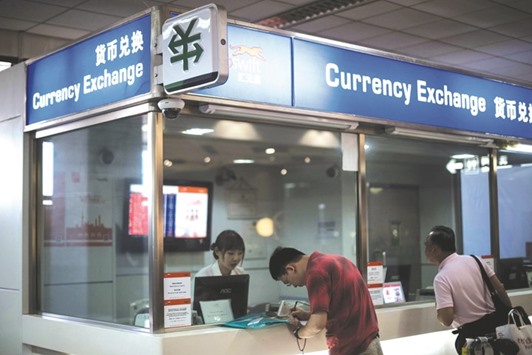The offshore yuan traded near a record low as Chinese policy makers signalled they are willing to allow greater currency flexibility amid a slump in exports and an advance in the dollar.
The exchange rate was little changed at 6.7828 per dollar in Hong Kong, after dropping to 6.7885, the weakest intraday level in data going back to 2010. In Shanghai, the currency was also little changed at 6.7771, close to a six- year low and past the 6.75 year-end median forecast in a Bloomberg survey.
The Chinese currency has come under increased pressure on signs that investors are taking more money out of the country.
A gauge of the dollar rose to a seven-month high versus major currencies Monday as traders bet that the Federal Reserve may raise borrowing costs soon.
Unlike the yuan selloff earlier this year which sparked a global market rout, there’s no sense of panic yet as policy makers maintain a steady exchange rate against other currencies.
“The central bank is tolerating more orderly depreciation of the yuan,” said Gao Qi, a Singapore-based foreign-exchange strategist at Scotiabank. “But it will step in to avoid market panic arising from a sharp yuan depreciation. The 6.8 level is critical in the near term.”
China will continue to keep the yuan “basically stable at a reasonable and equilibrium level,” PBoC Deputy Governor Yi Gang wrote in an article published by the local daily yesterday. There’s no basis for a persistent decline in the currency, which is more stable than other exchange rates in emerging markets, according to Yi, who used to head the nation’s foreign-exchange regulator.
The onshore yuan has weakened 4.2% this year, the most in Asia. It has declined in all but two sessions this month as some analysts speculated that the central bank has reduced support following the yuan’s inclusion in the International Monetary Fund’s basket of reserves on October 1.
A net $44.7bn worth of payments in the Chinese currency left the nation last month, according to data released by the State Administration of Foreign Exchange. That’s the most since the government started publishing the figures in 2010.
“Market sentiment is getting uneasy at the margin due to the offshore yuan’s slide, but in general it’s under control and there’s no panic-selling,” said Harrison Hu, chief greater China economist at Royal Bank of Scotland Group in Singapore. “There are still tight capital curbs, and investors are used to yuan depreciation, so such a drop is no longer a shock. As long as there’s no obvious panic, the PBoC will tolerate further declines - this is how China makes the exchange rate more flexible.”
The yuan’s depreciation in October has been driven mostly by gains in the dollar, and the Chinese currency will be supported if foreign funds continuously enter China, said Ma Jun, chief economist of the PBoC’s research bureau. The odds of a US interest-rate increase by year-end climbed to 71%, from less than 10% at the end of June, according to Fed fund futures trading.
Chinese policy makers have downplayed the importance of the yuan-dollar exchange rate, saying they aim to keep the yuan steady against a broad basket of currencies.
A Bloomberg gauge mimicking China Foreign Exchange Trade System’s yuan index against 13 major currencies has been little changed around 94 since August after falling more than 6% in the previous eight months.
There are few signs that the yuan selloff is becoming disorderly. By tightening capital controls and taking steps to support economic growth, the authorities have dispelled currency speculators.
The one-month implied volatility in the offshore yuan has dropped to about 4%, from more than 10% in February, suggesting investors expected more muted currency swings.
The gap between the offshore and onshore yuan, a sign of foreign investors speculating on the Chinese currency, has almost disappeared.

A man changes foreign currency into yuan at an exchange office in Shanghai airport. The offshore yuan traded near a record low as Chinese policy makers signalled they are willing to allow greater currency flexibility amid a slump in exports and an advance in the dollar.


